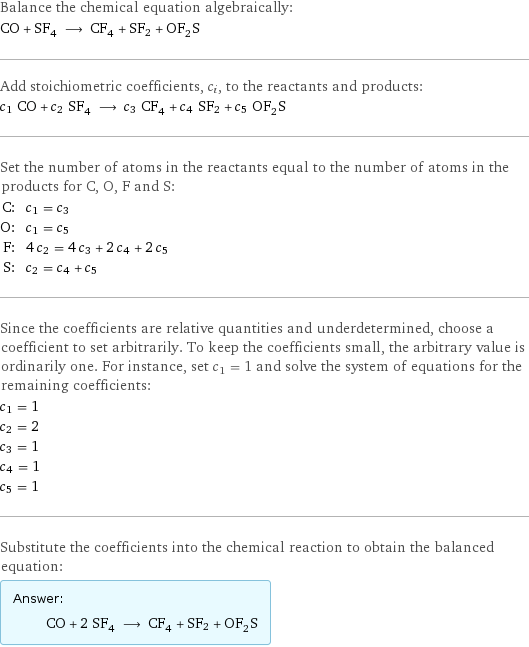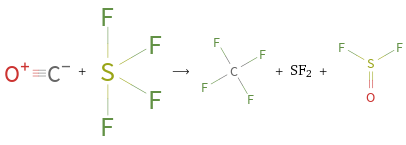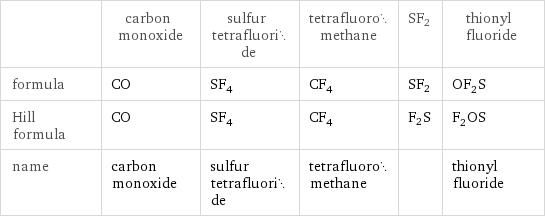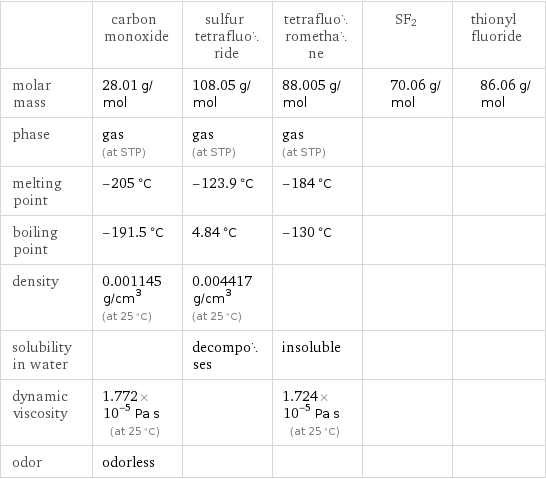Input interpretation

CO carbon monoxide + SF_4 sulfur tetrafluoride ⟶ CF_4 tetrafluoromethane + SF2 + OF_2S thionyl fluoride
Balanced equation

Balance the chemical equation algebraically: CO + SF_4 ⟶ CF_4 + SF2 + OF_2S Add stoichiometric coefficients, c_i, to the reactants and products: c_1 CO + c_2 SF_4 ⟶ c_3 CF_4 + c_4 SF2 + c_5 OF_2S Set the number of atoms in the reactants equal to the number of atoms in the products for C, O, F and S: C: | c_1 = c_3 O: | c_1 = c_5 F: | 4 c_2 = 4 c_3 + 2 c_4 + 2 c_5 S: | c_2 = c_4 + c_5 Since the coefficients are relative quantities and underdetermined, choose a coefficient to set arbitrarily. To keep the coefficients small, the arbitrary value is ordinarily one. For instance, set c_1 = 1 and solve the system of equations for the remaining coefficients: c_1 = 1 c_2 = 2 c_3 = 1 c_4 = 1 c_5 = 1 Substitute the coefficients into the chemical reaction to obtain the balanced equation: Answer: | | CO + 2 SF_4 ⟶ CF_4 + SF2 + OF_2S
Structures

+ ⟶ + SF2 +
Names

carbon monoxide + sulfur tetrafluoride ⟶ tetrafluoromethane + SF2 + thionyl fluoride
Equilibrium constant
![Construct the equilibrium constant, K, expression for: CO + SF_4 ⟶ CF_4 + SF2 + OF_2S Plan: • Balance the chemical equation. • Determine the stoichiometric numbers. • Assemble the activity expression for each chemical species. • Use the activity expressions to build the equilibrium constant expression. Write the balanced chemical equation: CO + 2 SF_4 ⟶ CF_4 + SF2 + OF_2S Assign stoichiometric numbers, ν_i, using the stoichiometric coefficients, c_i, from the balanced chemical equation in the following manner: ν_i = -c_i for reactants and ν_i = c_i for products: chemical species | c_i | ν_i CO | 1 | -1 SF_4 | 2 | -2 CF_4 | 1 | 1 SF2 | 1 | 1 OF_2S | 1 | 1 Assemble the activity expressions accounting for the state of matter and ν_i: chemical species | c_i | ν_i | activity expression CO | 1 | -1 | ([CO])^(-1) SF_4 | 2 | -2 | ([SF4])^(-2) CF_4 | 1 | 1 | [CF4] SF2 | 1 | 1 | [SF2] OF_2S | 1 | 1 | [O1F2S1] The equilibrium constant symbol in the concentration basis is: K_c Mulitply the activity expressions to arrive at the K_c expression: Answer: | | K_c = ([CO])^(-1) ([SF4])^(-2) [CF4] [SF2] [O1F2S1] = ([CF4] [SF2] [O1F2S1])/([CO] ([SF4])^2)](../image_source/3bb86ca1d4fc74b54ad17e343153902b.png)
Construct the equilibrium constant, K, expression for: CO + SF_4 ⟶ CF_4 + SF2 + OF_2S Plan: • Balance the chemical equation. • Determine the stoichiometric numbers. • Assemble the activity expression for each chemical species. • Use the activity expressions to build the equilibrium constant expression. Write the balanced chemical equation: CO + 2 SF_4 ⟶ CF_4 + SF2 + OF_2S Assign stoichiometric numbers, ν_i, using the stoichiometric coefficients, c_i, from the balanced chemical equation in the following manner: ν_i = -c_i for reactants and ν_i = c_i for products: chemical species | c_i | ν_i CO | 1 | -1 SF_4 | 2 | -2 CF_4 | 1 | 1 SF2 | 1 | 1 OF_2S | 1 | 1 Assemble the activity expressions accounting for the state of matter and ν_i: chemical species | c_i | ν_i | activity expression CO | 1 | -1 | ([CO])^(-1) SF_4 | 2 | -2 | ([SF4])^(-2) CF_4 | 1 | 1 | [CF4] SF2 | 1 | 1 | [SF2] OF_2S | 1 | 1 | [O1F2S1] The equilibrium constant symbol in the concentration basis is: K_c Mulitply the activity expressions to arrive at the K_c expression: Answer: | | K_c = ([CO])^(-1) ([SF4])^(-2) [CF4] [SF2] [O1F2S1] = ([CF4] [SF2] [O1F2S1])/([CO] ([SF4])^2)
Rate of reaction
![Construct the rate of reaction expression for: CO + SF_4 ⟶ CF_4 + SF2 + OF_2S Plan: • Balance the chemical equation. • Determine the stoichiometric numbers. • Assemble the rate term for each chemical species. • Write the rate of reaction expression. Write the balanced chemical equation: CO + 2 SF_4 ⟶ CF_4 + SF2 + OF_2S Assign stoichiometric numbers, ν_i, using the stoichiometric coefficients, c_i, from the balanced chemical equation in the following manner: ν_i = -c_i for reactants and ν_i = c_i for products: chemical species | c_i | ν_i CO | 1 | -1 SF_4 | 2 | -2 CF_4 | 1 | 1 SF2 | 1 | 1 OF_2S | 1 | 1 The rate term for each chemical species, B_i, is 1/ν_i(Δ[B_i])/(Δt) where [B_i] is the amount concentration and t is time: chemical species | c_i | ν_i | rate term CO | 1 | -1 | -(Δ[CO])/(Δt) SF_4 | 2 | -2 | -1/2 (Δ[SF4])/(Δt) CF_4 | 1 | 1 | (Δ[CF4])/(Δt) SF2 | 1 | 1 | (Δ[SF2])/(Δt) OF_2S | 1 | 1 | (Δ[O1F2S1])/(Δt) (for infinitesimal rate of change, replace Δ with d) Set the rate terms equal to each other to arrive at the rate expression: Answer: | | rate = -(Δ[CO])/(Δt) = -1/2 (Δ[SF4])/(Δt) = (Δ[CF4])/(Δt) = (Δ[SF2])/(Δt) = (Δ[O1F2S1])/(Δt) (assuming constant volume and no accumulation of intermediates or side products)](../image_source/44dcd2dd1b20e7ea1e38823c36b35328.png)
Construct the rate of reaction expression for: CO + SF_4 ⟶ CF_4 + SF2 + OF_2S Plan: • Balance the chemical equation. • Determine the stoichiometric numbers. • Assemble the rate term for each chemical species. • Write the rate of reaction expression. Write the balanced chemical equation: CO + 2 SF_4 ⟶ CF_4 + SF2 + OF_2S Assign stoichiometric numbers, ν_i, using the stoichiometric coefficients, c_i, from the balanced chemical equation in the following manner: ν_i = -c_i for reactants and ν_i = c_i for products: chemical species | c_i | ν_i CO | 1 | -1 SF_4 | 2 | -2 CF_4 | 1 | 1 SF2 | 1 | 1 OF_2S | 1 | 1 The rate term for each chemical species, B_i, is 1/ν_i(Δ[B_i])/(Δt) where [B_i] is the amount concentration and t is time: chemical species | c_i | ν_i | rate term CO | 1 | -1 | -(Δ[CO])/(Δt) SF_4 | 2 | -2 | -1/2 (Δ[SF4])/(Δt) CF_4 | 1 | 1 | (Δ[CF4])/(Δt) SF2 | 1 | 1 | (Δ[SF2])/(Δt) OF_2S | 1 | 1 | (Δ[O1F2S1])/(Δt) (for infinitesimal rate of change, replace Δ with d) Set the rate terms equal to each other to arrive at the rate expression: Answer: | | rate = -(Δ[CO])/(Δt) = -1/2 (Δ[SF4])/(Δt) = (Δ[CF4])/(Δt) = (Δ[SF2])/(Δt) = (Δ[O1F2S1])/(Δt) (assuming constant volume and no accumulation of intermediates or side products)
Chemical names and formulas

| carbon monoxide | sulfur tetrafluoride | tetrafluoromethane | SF2 | thionyl fluoride formula | CO | SF_4 | CF_4 | SF2 | OF_2S Hill formula | CO | SF_4 | CF_4 | F2S | F_2OS name | carbon monoxide | sulfur tetrafluoride | tetrafluoromethane | | thionyl fluoride
Substance properties

| carbon monoxide | sulfur tetrafluoride | tetrafluoromethane | SF2 | thionyl fluoride molar mass | 28.01 g/mol | 108.05 g/mol | 88.005 g/mol | 70.06 g/mol | 86.06 g/mol phase | gas (at STP) | gas (at STP) | gas (at STP) | | melting point | -205 °C | -123.9 °C | -184 °C | | boiling point | -191.5 °C | 4.84 °C | -130 °C | | density | 0.001145 g/cm^3 (at 25 °C) | 0.004417 g/cm^3 (at 25 °C) | | | solubility in water | | decomposes | insoluble | | dynamic viscosity | 1.772×10^-5 Pa s (at 25 °C) | | 1.724×10^-5 Pa s (at 25 °C) | | odor | odorless | | | |
Units
